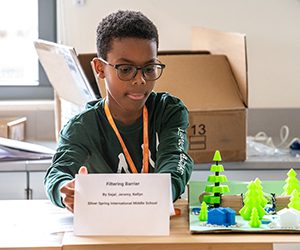In 2021, more than 200,000 students worldwide completed the Advanced Placement (AP) Biology exam. AP Biology aims to prepare high school students for two semesters of college-level introductory biology and to cultivate laboratory skills through inquiry-based experimentation. Students can even receive college credits based on their overall score on the final exam. AP Biology and other advanced placement courses thus serve as onramps to college-level study and future career paths in STEM.
Yet, more than half a million students of color and students from low-income backgrounds are missing from AP participation, according to a 2013 report from The Education Trust, and by extension, from the valuable foundation these courses offer for success in academics and work. This is not because schools lack AP offerings — fewer than 1 in 10 students attend schools that don’t even offer AP courses. Instead, the majority of these missing students are not being equitably recruited for, enrolled in, and prepared for AP courses. According to a 2022 report by Ed Trust and Equal Opportunity Schools (EOS), only 3% of eligible Black and Latino students are enrolled in AP STEM classes.
To narrow the gap in AP participation, school and district leaders must challenge the biases that lead to the exclusion of students from low-income backgrounds and students of color, especially Black and Latino students. Ed Trust and EOS co-created a brief, “5 Questions to Ask District and School Leaders About Access to Advanced STEM Coursework in High School” to help families, advocates, and communities call for more inclusive and equitable practices. But students, families, and teachers also need ongoing support after students enroll in advanced courses. LabXchange, an initiative of Harvard’s Vice Provost for Advances in Learning supported by the Amgen Foundation, aims to help students succeed in advanced STEM coursework through a suite of free resources aligned with the AP Biology curriculum.
LabXchange makes high-quality science education accessible, connects learning to careers, and gives everyone, everywhere, the opportunity to chart a path in science through a powerful digital platform for science education and an expansive library of world-class learning resources and. In addition to the 20,000 learning resources currently available, new AP Biology resources will be released starting in 2023 as clusters, or thematic groupings of resources, entitled Biochemistry, Cells & Energetics; Cell Communication, Heredity & Gene Expression; and Evolution & Ecology. As they navigate the clusters, educators and learners will engage with virtual lab simulations, videos, assessments, and other interactive digital content. In the meantime, educators may access additional resources such as the Core Concepts in Biology cluster.
“Virtual tools, such as simulations, allow students to interact with complex lab topics in advance of hands-on experimentation, thus preparing all learners for success during class. This approach increases access to AP topics for a variety of learners who may otherwise struggle with the rigor and pace of a college-level course,” says Stefana Dunn, LabXchange high school content lead.
All the learning resources in the three clusters can be saved, shared, or remixed with alternative educational content from the LabXchange library or educators’ own desktops. This allows educators to personalize online learning for a wide variety of teaching contexts, prepare students for laboratory experiences, and nurture a sense of belonging in STEM. “Currently, AP Biology teachers are faced with deciphering lengthy standards. By setting a clear scope and sequence, our team is creating an easy-to-use suite of resources that align with the standards, and incorporating enrichment opportunities,” says Dunn. “We’re also strategically scaffolding assets to ensure that teachers can help meet each student where they are, and make up for possible gaps in background knowledge and preparation.”
With digital tools like LabXchange, opportunities for enrichment and engagement extend beyond the end of the school day and outside the confines of the classroom. According to Mary Liu, LabXchange high school teacher-in-residence and a science teacher at Weston High School in Weston, Massachusetts, “Some of the main constraints that I face are highly limited time, resources, and budget for hands-on labs. By giving students experience before a hands-on lab or giving them a chance to review a virtual lab afterwards, I can better enable students with varying backgrounds to achieve at the AP level.”
Finally, to further a sense of belonging, the LabXchange AP Biology clusters will incorporate career narratives showcasing a diverse range of scientists and roles in STEM. According to Ed Trust and EOS, when students see themselves reflected in the curriculum and in other students in the class, students are more likely to feel welcome in AP courses. AP teachers and students will also have access to forthcoming resources from the Racial Diversity, Equity, and Inclusion in Science Education project, which aims to equip educators with inclusive teaching strategies.
In short, Advanced Placement STEM courses offer many benefits, from the development of scientific thinking skills to actual college credits. Every student deserves to be recruited for, enrolled in, and supported in these rigorous, valuable experiences. With the online learning resources provided by LabXchange, and the advocacy tools offered by Ed Trust and EOS, including this brief, 5 Questions to Ask District and School Leaders About Access to Advanced STEM Coursework in High School, communities have the power to help all students thrive in AP courses, regardless of their race or income level.







